原创 马明医生 马明医生
来自专辑
近视防控

The lens is located in the eye. By changing its shape, the lens changes the focal distance of the eye. In other words, it focuses the light rays that pass through it (and onto the retina) in order to create clear images of objects that are positioned at various distances. It also works together with the cornea to refract, or bend, light.
晶状体位于眼中,通过改变其形状,晶状体可以改变眼睛的焦距。 换言之,它将穿过它的光线聚焦在视网膜上,以获得不同距离物体的清晰图像,它与角膜一起折射或弯曲光线。
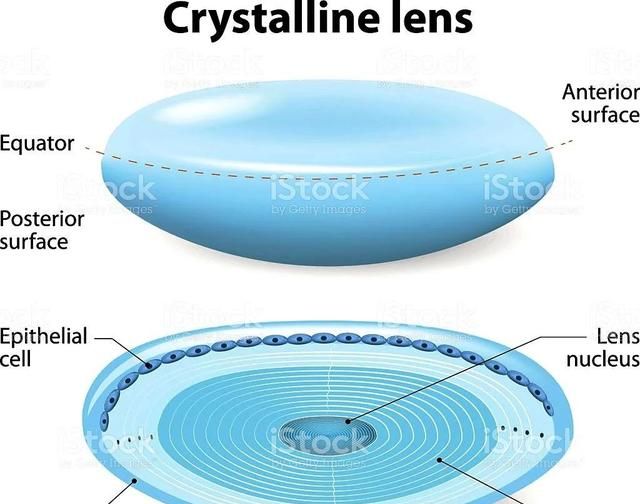
Lens shape and structure
The lens is a biconvex, avascular, noninnervated, encapsulated body composed entirely of epithelial cells and fibers. The lens is of ellipsoid. An ellipsoid is similar to a sphere but stretched out, like an olive, and biconvex means it’s rounded outward on both sides. The lens is about 10 mm across and 4 mm from front to back in adults, although its shape and size varies as it changes its focus.
The lens consists of the lens capsule, the lens epithelium, and the lens fibers. The lens capsule is the smooth, transparent outermost layer of the lens, while the lens fibers are long, thin, transparent cells that form the bulk of the lens. Lens transparency depends on tight, regular packing of lens fibers and their intracellular proteins to permit light transmission and provide refractive power for accommodation (focusing on near objects).The lens epithelium lies between these two and is responsible for the stable functioning of the lens. It also creates lens fibers for the lifelong growth of the lens.
晶状体形状和结构
晶状体是一个双凸体,无血管,无神经支配的包膜体,完全由上皮细胞和纤维组成。晶状体是椭球面,像橄榄一样外展,类似于球体,双凸体表示它的两面都是圆的。虽然它的形状和大小会随着焦距的变化而变化,但成年人的晶状体较稳定,直径约为10毫米,前后相差4毫米。
晶状体由晶状体囊、晶状体上皮和晶状体纤维组成。晶状体囊是晶状体光滑透明的最外层,而晶状体纤维是长而薄的透明细胞,构成晶状体的主体。晶状体的透明度取决于晶状体纤维和细胞内蛋白质的紧密、规则的堆积,以允许光通过,并提供适应(聚焦近的物体)的折射能力。晶状体上皮位于这两者之间,负责晶状体的稳定功能。它还为晶状体的终身生长提供晶状体纤维。
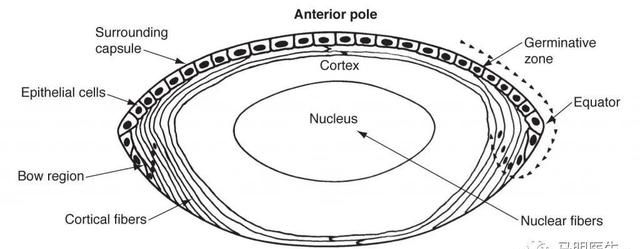
Anatomical position of the lens
The lens is suspended just posteriorly to the iris and divides the anterior and posterior segments of the eye. The posterior surface of the lens itself is attached to the vitreous humor at Wieger’s Ligament (also known as Hyaloideo capsulare).
Zonular fibers attach to the outer layer of the lens capsule (the zonular lamella) and hold the lens in place. Zonular fibers originate in the basal lamina of the pars plana and pars plicata of the ciliary body and insert on the equatorial region of the lens.
晶状体的解剖位置
晶状体悬吊在虹膜的后方,把眼睛的前后部分分开。晶状体的后表面附着在玻璃体的韦格韧带(也称为透明囊)上。
悬韧带纤维附着在晶状体囊的外层(带状板层)上,将晶状体固定在适当的位置。悬韧带纤维起源于纤毛扁平部和睫状体扁平部的基底板,并插入到晶状体的赤道区域。
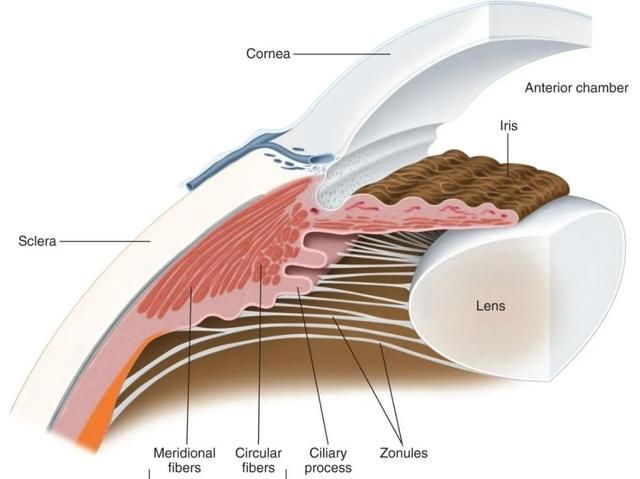
Optical function of the lens
The main optical function of the lens is to transmit light, focusing it on the retina. The cornea contributes about 80% of total refraction, while the lens fine-tunes the focusing of light onto the retina. Although the human lens is colorless at birth, there is a gradual increase in yellowish pigmentation with age probably due to the production of 3-hydroxykynurenine and other metabolites of tryptophan that filter UV light. The lens transmits light with wavelengths up to 1200 nm efficiently, but transmits very little light below 390 nm. 1200 nm is well above the limit of visual perception, about 720 nm. As discussed previously, the architecture and cellular contents of the lens are critical for its transparency. The transparency and high-refractive index of cells in the lens result from tight packing of their proteins, providing a constant refractive index over distances approximating the wavelength of the transmitted light. In fact, as lens proteins are diluted to concentrations below that found in the lens, about 450 mg/ml, light scattering actually increases, because dilution decreases the weak interactions between unlike proteins that occur at high concentrations and help to maintain lens transparency. Finally, there is a gradual increase in the refractive index of the human lens from 1.38 (73–80% H2O) in the cortex to 1.42 (68%H2O) in the nucleus, in part due to an enrichment of tightly packed γ-crystallins.
晶状体的光学功能
晶状体的主要光学功能是传输光线,将其聚焦在视网膜上。角膜贡献了大约80%的折射能力,而晶状体对光线聚焦在视网膜上进行微调。尽管人类晶状体在出生时是无色的,但随着年龄的增长,淡黄色的色素逐渐增加,这可能是由于产生了3-羟基犬尿氨酸和其他色氨酸的代谢产物过滤了紫外线。晶状体能有效地传输波长高达1200纳米的光,但在390纳米以下的光传输非常少,1200纳米远高于720纳米视觉感知的极限。如前所述,晶状体的结构和细胞成分对其透明度至关重要。晶体中细胞的透明度和高折射率是由于它们的蛋白质紧密包裹,从而在近似于透射光波长的距离范围内提供恒定的折射率。实际上,当将晶状体蛋白稀释到低于晶状体中的浓度(约450mg /ml)时,光散射实际上会增加,因为稀释会降低高浓度下不同蛋白之间的弱相互作用,并有助于保持晶状体透明性。人类晶状体的折射率从皮质的1.38(73-80%H2O)逐渐增加到核的1.42(68%H2O),部分原因是紧密堆积的γ-晶状体蛋白的含量不同。
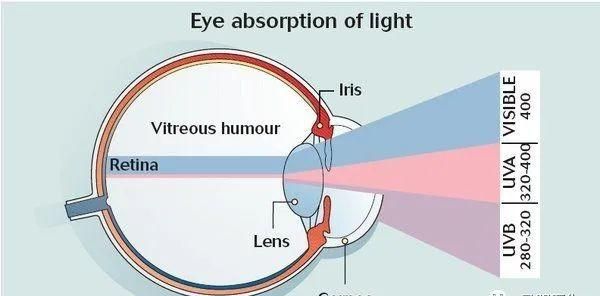
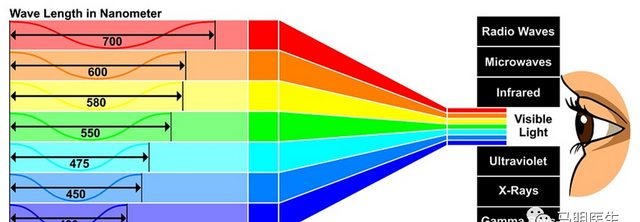
晶状体正常值:
晶体直径:出生时6.5mm,发育后9-10mm
晶体厚度:出生时3.5mm,其余为5mm
晶体重量:135-255mg
晶体前表面曲率半径:无调节时10mm,调节时6mm
晶体后表面曲率半径:6mm
晶体折射率:1.39(核心1.42,皮层1.38)
晶体折射率:16-17D
晶体调节能力:出生时14-16D,25岁7-8D,50岁时1-2D
近点:10岁时7cm,30岁时14cm,40岁时25cm,45岁时33cm

版权声明:本文来自用户投稿,不代表【闪电鸟】立场,本平台所发表的文章、图片属于原权利人所有,因客观原因,或会存在不当使用的情况,非恶意侵犯原权利人相关权益,敬请相关权利人谅解并与我们联系(邮箱:dandanxi6@qq.com)我们将及时处理,共同维护良好的网络创作环境。
